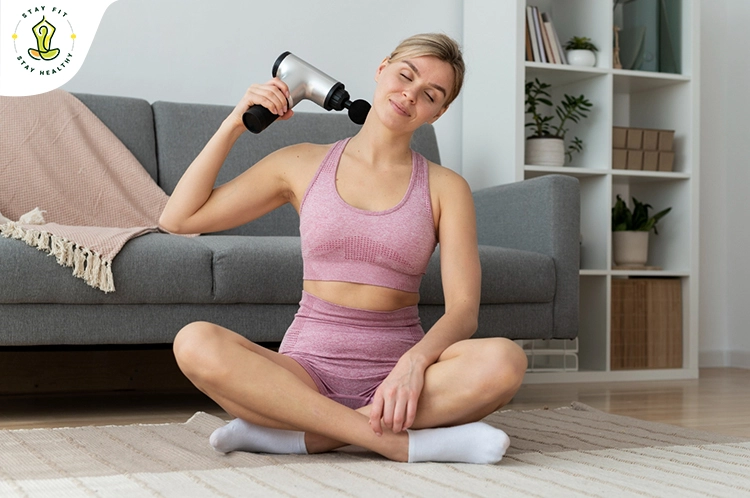Massage guns have become a popular medical and fitness tool, promising rapid relief from muscle soreness, improved recovery, and enhanced athletic performance. These handheld devices deliver percussive therapy, using rapid pulses of pressure to target specific muscle groups. While often marketed as a consumer product, massage guns are increasingly finding their place within the realm of physical therapy.
Physical therapists, with their deep understanding of the human body and its mechanics, are exploring the potential benefits of massage guns as a complementary tool in their treatment plans. In this article, we will talk about massage guns, explaining how they work, massage guns benefits in physical therapy, and how to use them safely and effectively. So, without further ado, let’s find out how these little machines can revolutionize the way physical therapists approach muscle recovery and pain management.
Benefits of Massage Guns in Physical Therapy
Massage guns offer a range of potential benefits that align with the goals of physical therapy. By addressing common musculoskeletal issues, these devices can complement traditional treatment methods and enhance patient outcomes.
 (source:-stayhealthyandstayfit)
(source:-stayhealthyandstayfit)
Pain Relief
One of the most sought-after benefits of massage guns is pain relief. The percussive action can help to:
- Reduce muscle soreness and stiffness
- Alleviate tension headaches associated with neck and shoulder muscle tightness
- Diminish discomfort caused by conditions like plantar fasciitis
Improved Range of Motion
By breaking down muscle adhesions and increasing blood flow, massage guns can contribute to improved flexibility and range of motion. This can be particularly beneficial for individuals with:
- Limited joint mobility
- Tight muscles
- Post-operative stiffness
Faster Recovery
Massage guns can accelerate the recovery process by:
- Reducing inflammation
- Removing lactic acid build-up
- Promoting tissue repair
Athletes and individuals undergoing physical rehabilitation can benefit from the potential of massage guns to expedite healing and return to activity.
Enhanced Blood Flow
As mentioned earlier, massage guns stimulate blood circulation. This increased blood flow delivers essential nutrients and oxygen to the muscles, which can:
- Reduce muscle fatigue
- Improve overall tissue health
- Enhance performance
Reduced Inflammation
The anti-inflammatory effects of massage guns can be attributed to increased blood flow and the breakdown of muscle tension. This can help to:
- Minimize swelling
- Reduce pain
- Promote healing
By understanding the potential benefits of massage guns, physical therapists can effectively incorporate this tool into their treatment plans to optimize patient care.
How Massage Guns Work
Massage guns, also known as percussive therapy devices, operate on a simple yet effective principle. They utilize a motor to rapidly oscillate a head against the body, delivering a series of percussive impacts. These impacts penetrate deep into the muscle tissue, creating vibrations that elicit a physiological response.
The science behind muscle massage guns is centered on the body’s reaction to this rapid stimulation. The percussive action helps to:
- Increase blood flow: The vibration therapy dilates blood vessels, enhancing circulation and delivering oxygen and nutrients to the muscles.
- Reduce muscle tension: Rapid pulses can help break down muscle knots and adhesions, release tension, and improve flexibility.
- Accelerate recovery: By promoting blood flow and reducing inflammation, massage guns can expedite the healing process after workouts or injuries.
Massage guns typically come equipped with interchangeable heads, each designed for specific purposes. For instance:
- Round head: Ideal for general muscle relaxation and warm-up.
- Flathead: Suitable for targeting larger muscle groups.
- Bullet head: Designed for deep tissue work and trigger point relief.
- Forkhead: Used for working on muscles between the spine and shoulder blades.
The effectiveness of massage gun therapy is often influenced by the intensity and speed settings. Lower intensity and slower speeds are generally recommended for beginners or sensitive areas, while higher settings can be used for deeper tissue work and athletes.
Who Can Benefit from a Massage Gun?
Massage guns are versatile tools that can benefit a wide range of individuals. From athletes seeking faster recovery to office workers looking for relief from muscle tension, these devices offer numerous advantages. Let’s explore who can benefit from using a massage gun.
| User Group | Benefits |
| Athletes and Fitness Enthusiasts | Accelerated recovery, improved performance, injury prevention |
| Office Workers and Sedentary Individuals | Relieves muscle tension, improves posture, reduces stress |
| Seniors | Pain management, improved mobility, enhanced circulation |
| Individuals with Specific Conditions | Chronic pain relief, muscle injury recovery, post-surgery rehabilitation |
Using Massage Guns Safely and Effectively
While muscle massager guns offer numerous benefits, it’s crucial to use them correctly to avoid potential harm and maximize their effectiveness.
General Safety Guidelines
- Consult with a healthcare professional: Individuals with specific medical conditions or injuries should seek advice from a physical therapist or doctor before using a massage gun.
- Start low and slow: Begin with lower intensity and speed settings and gradually increase as tolerated.
- Avoid bony areas: Focus on muscle tissue and avoid applying pressure to bones.
- Listen to your body: Discontinue use if you experience increased pain or discomfort.
- Maintain good posture: Proper body alignment can prevent strain during use.
Contraindications and Precautions
- Acute injuries: Avoid using a massage gun on recent injuries or inflamed areas.
- Blood clots: Individuals with a history of blood clots should consult with a healthcare provider before use.
- Pregnancy: Pregnant women should consult with their healthcare provider before using a massage gun.
- Skin conditions: Avoid using the massage gun on irritated or broken skin.
and activity level to estimate caloric expenditure.
Proper Technique and Positioning
- Glide the massage gun: Move the device smoothly over the muscle, avoiding stationary pressure.
- Vary the angle: Experiment with different angles to target specific muscle fibers.
- Use appropriate attachments: Choose the correct head based on the targeted muscle group.
Intensity and Duration
- Start low: Begin with lower intensity settings and gradually increase as tolerated.
- Listen to your body: Adjust the intensity based on your comfort level.
- Limit duration: Excessive use can lead to muscle fatigue.
By following these guidelines, individuals can safely and effectively incorporate massage guns into their wellness routine.
Incorporating Massage Guns into a Physical Therapy Plan
Massage Guns as a Complementary Tool
Physical therapists can integrate massage guns into their practice in several ways:
- Pre-treatment warm-up: Using massage guns to loosen tight muscles before manual therapy or exercise.
- Post-treatment recovery: It can be used as muscle recovery tools accelerating muscle recovery and reducing soreness after therapy sessions.
- Home exercise program: Providing patients with massage guns for self-care between appointments.
Combining Massage Guns with Other Therapies
Massage guns can be effectively combined with other physical therapy modalities, such as:
- Stretching: Improving flexibility and range of motion.
- Strength training: Enhancing muscle activation and performance.
- Manual therapy: Increasing tissue relaxation and reducing pain.
Conditions Benefiting from Massage Gun Therapy
While massage guns can be beneficial for a wide range of conditions, some specific examples include:
- Muscle strains and sprains: Accelerating healing and reducing pain.
- Chronic pain syndromes: Providing temporary relief and improving function.
- Post-surgical rehabilitation: Managing scar tissue and reducing pain.
Individualized Treatment Plans
 (source:-stayhealthyandstayfit)
(source:-stayhealthyandstayfit)
By incorporating massage guns into their practice, physical therapists can offer patients a more comprehensive and effective approach to post workout recovery and pain management.
Conclusion
Massage guns have emerged as a promising tool in the field of physical therapy. By understanding how these devices work and their potential benefits, healthcare providers can effectively incorporate them into treatment plans.
Massage guns offer a range of advantages when used correctly, from pain relief and improved range of motion to faster recovery and enhanced blood flow. However, it is essential to emphasize the importance of consulting with a physical therapist for personalized guidance and to ensure safe and effective use.
While research on massage guns is still evolving, the potential for these devices to complement traditional physical therapy interventions is undeniable. By combining expert care with innovative technology, healthcare professionals can help patients achieve optimal outcomes and enhance their overall well-being.

